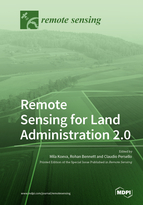Remote Sensing for Land Administration 2.0
A special issue of Remote Sensing (ISSN 2072-4292). This special issue belongs to the section "Urban Remote Sensing".
Deadline for manuscript submissions: closed (30 November 2021) | Viewed by 33337
Special Issue Editors
Interests: 3D land information; photogrammetry and remote sensing; UAV; 3D modeling and visualization/digital twins
Special Issues, Collections and Topics in MDPI journals
Interests: ICT4D; land informatics; digital business
Special Issues, Collections and Topics in MDPI journals
Interests: remote sensing; machine learning; deep learning
Special Issues, Collections and Topics in MDPI journals
Special Issue Information
Dear Colleagues,
This Special Issue will contribute to the rapidly growing discourse on the use of remote sensing to Land administration (LA). Contemporary LA systems incorporate the concepts of cadastre and land registration. Conceptually, LA is part of a global land management paradigm incorporating land administration functions such as land value, land tenure, land development, and land use. The implementation of land-related policies integrated with well-maintained spatial information reflects the aim set by the United Nations to deliver tenure security for all (Sustainable Development Goal target 1.4, amongst others). In response to the global challenges of urbanization, complex urban infrastructure, innovative methods for data acquisition, processing, and maintaining spatial information are needed. Current technological developments in remote sensing and spatial information science provide enormous opportunities in this respect. Over the past decade, the increasing usage of unmanned aerial vehicles (UAVs), active remote sensing techniques as LiDAR and RADAR, resulted in data with high spatial, spectral, radiometric, and temporal resolution. Moreover, significant progress has also been achieved in automatic image orientation, surface reconstruction, scene analysis, change detection, classification, and automatic feature extraction with the help of artificial intelligence, spatial statistics, and machine learning. These technology developments, applied to LA, are now being actively demonstrated, piloted, and scaled. Therefore, building from the popularity of the earlier ‘Remote Sensing for Land Administration’ Special Issue in Remote Sensing, the specific focus of this Special Issue is exploring the usage and integration of emerging remote sensing techniques and their potential contribution to the domain of land administration. In this sense, the ‘2.0’ in the title refers both to this Special Issue being the second volume on the topic, and also the next-generation requirements of LA including demands for 3D, indoor, and real-time land data and information.
Topics may include but are not limited to the following:
- Comparisons of remote sensing techniques for 2D and 3D data acquisition, processing, modelling, and analysis in support of land tenure mapping, land valuation, taxation, etc.
- Design and testing of techniques for feature extraction/boundary delineation from remotely-sensed data sources (including semi-automated methods, algorithm design, and object-based approaches)
- Reviews of leading scientific advances in data integration and utilization for 2D and 3D land administration
Dr. Mila Koeva
Dr. Rohan Bennett
Dr. Claudio Persello
Guest Editors
Manuscript Submission Information
Manuscripts should be submitted online at www.mdpi.com by registering and logging in to this website. Once you are registered, click here to go to the submission form. Manuscripts can be submitted until the deadline. All submissions that pass pre-check are peer-reviewed. Accepted papers will be published continuously in the journal (as soon as accepted) and will be listed together on the special issue website. Research articles, review articles as well as short communications are invited. For planned papers, a title and short abstract (about 100 words) can be sent to the Editorial Office for announcement on this website.
Submitted manuscripts should not have been published previously, nor be under consideration for publication elsewhere (except conference proceedings papers). All manuscripts are thoroughly refereed through a single-blind peer-review process. A guide for authors and other relevant information for submission of manuscripts is available on the Instructions for Authors page. Remote Sensing is an international peer-reviewed open access semimonthly journal published by MDPI.
Please visit the Instructions for Authors page before submitting a manuscript. The Article Processing Charge (APC) for publication in this open access journal is 2700 CHF (Swiss Francs). Submitted papers should be well formatted and use good English. Authors may use MDPI's English editing service prior to publication or during author revisions.
Keywords
- Land management
- Land information
- 2D and 3D land data
- Feature extraction
- Machine learning for LA
- Artificial intelligence for LA
- UAVs
- Land tenure (cadastre) mapping
- Land registration
- Land valuation and taxation
- Land use planning and development








